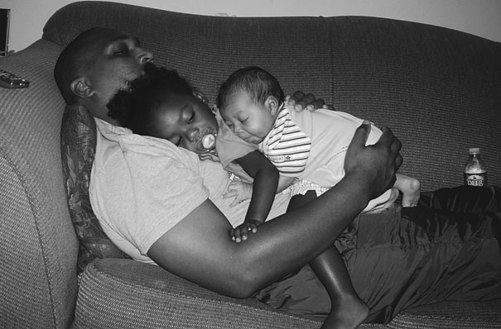The No Cry Nap Solution (9 page)
Read The No Cry Nap Solution Online
Authors: Elizabeth Pantley

Nap Tips for Newborns
Now that we’ve covered some basic information about new-
born sleep, we’ll move on to some tips for working with your
baby’s natural biology. By respecting and understanding his needs
you can respond to him in ways that bring the best sleep for your
baby, and for you, too.
Learn to Differentiate Between Sleeping
Sounds and Awaking Sounds
When you put your newborn down for a nap and later hear noises,
don’t immediately run to pick her up. First, stop and listen for a few
minutes, and then peek in on her without her seeing you. If you
are co-sleeping with your baby and he begins to make noises, don’t
move—just listen. Cue in to your baby’s sounds and movements
to determine if he is awake, making sleeping noises, or shifting
sleep cycles. Many babies have amazing radar and can tell when
Mommy or Daddy is awake or hovering at the doorway, so use a
baby monitor or stay out of sight until you know that your baby is
really awake.
If your baby is awake and hungry, you’ll want to feed her, of
course. You don’t want her to have to cry to get your attention.
But if she’s just being a noisy sleeper or moving through her sleep
cycle, let her be, and let her sleep!
Watch for Signs of Tiredness
Possibly the most effective newborn tip is to get familiar with your
baby’s sleepy signals and put him down for a nap immediately
43
44 Newborn Babies
Mother-Speak
“I learned that I should never let my baby cry, so I went to
her the minute she made a peep. I was so proud of my baby-
soothing skills because half the time she would be back to
sleep by the time I got to the rocking chair. But then I real-
ized I was taking a sleeping baby from her cradle!
Now I give her ten minutes. If she doesn’t settle down but
still isn’t outright crying, I use a broomstick to lean over and
rock the cradle, and I turn on her white noise machine. Half
the time she does go back to sleep. To think of all the extra
sleep I could have had . . .”
—Andrea, mother to three-month-old Isabella
when he seems tired. A baby who is encouraged to stay awake
when his body is craving sleep is an unhappy baby. Over time
this pattern develops into sleep deprivation. A pattern of staying
awake past sleepiness also complicates developing sleep maturity;
it can disrupt your baby’s ability to fall asleep easily, leading to a
baby who requires a long, involved routine before every nap or
nighttime sleep.
Learn to read your baby’s sleepy signs and put him to bed as
soon as that window of opportunity presents itself. Watch your
baby for any of these common newborn sleepy signs:
• A lull in movement or activity; calm, slower movements
• Quieting down, making fewer or simpler sounds
• Losing interest in people and toys
• Appearing glazed or unfocused; staring off in the distance
• Fussing or whining
• Eyes open wide and unblinking
• Rubbing eyes or ears
• Yawning
• Being awake for one to three hours

Nap Tips for Newborns
45
Gabriel, one month old
Here are a few signs that your baby might be overtired or very
hungry:
• Fretful crying
• Arching backward or going rigid
• Flailing, jerky, uncoordinated movements of arms and legs
• Drooping eyelids, slow blinking, eyelids fl uttering
• Dark circles appearing under the eyes; eyes appearing
bloodshot
• Being awake for more than three hours
Determine If Your Baby Is
Hungry
or
Tired
Babies might fuss, whine, or cry if they are
either
tired or hun-
gry. So, how can you tell the difference? First, become familiar
46 Newborn Babies
with your baby’s usual tired signs from the previous list. Note your
baby’s behavior in the minutes before he either eats or falls asleep.
Since every child is unique, you will notice your particular baby’s
ways of communicating that she is tired or hungry.
You can often tell if your baby is fussing because she’s
hungry
if
she is rooting (moving her head back and forth and opening her
mouth), thrusting her tongue, sucking on her fi ngers or hands,
increasing her level of activity, or fussing and doesn’t stop when
you pick her up. The clock can also help you make this distinc-
tion—if it has been two to four hours since your baby’s last feed-
ing (depending on your baby’s typical pattern and whether she
is breastfed or bottlefed), her fussing is likely a sign of hunger.
According to the American Academy of Pediatrics, if your new-
born is crying, that is a
late
indicator of hunger, so watching for
these early hunger signs can prevent crying.
Use the Power of Daylight
A simple way to cue your baby toward a regular day/night sleep
schedule is by taking advantage of the effect that daylight has on
sleep patterns. There is a powerful structure wired into the human
brain right from birth that interprets daylight as active and alert
time. Within the fi rst few months of life, your baby will take in
these light cues to help consolidate sleep patterns.
The most effective light for signaling alert time is natural day-
light. Make an effort to expose your baby to daylight fi rst thing in
the morning. You might provide your baby’s fi rst feeding near a
window that lets in morning light. If it is dark outside, the second
choice is artifi cial light. You can also play with your baby in bright
daylight several times throughout the early part of the day, further-
ing the announcement that daytime is awake time. By doing this
consistently, you can help your baby organize his day and night
sleeping pattern.
Nap Tips for Newborns
47
Encourage Sleepiness with Darkness Cues
The second half of the biological sleep-cue equation is that dark-
ness signals to the brain that it is time to sleep. Darkness encour-
ages the release of the body’s natural sleep hormone, melatonin.
This is a very powerful natural phenomenon that allows your baby
to be tired and fall asleep easily at bedtime.
Babies will tend toward an early bedtime, around 6:30 or 7:00
p.m., but since this is hours away from the parent’s bedtime, the
house can be lit up as bright as daytime. The bright light signals
to your baby’s brain that it is time to be alert and active. You can
protect this natural melatonin-creation process by keeping the
lights dimmed in the hour before your baby’s bedtime.
A second aspect to this process involves keeping the darkness
throughout the night. Even a small night-light can disrupt sleepi-
ness and begin the alerting process—which you don’t want hap-
pening at 2:00 in the morning! Keep night-lights small and away
from your baby’s face. Keep glowing clocks turned away from your
baby’s bed. Don’t turn on bright lights or the television during
midnight feedings. Darkness can keep your baby in a sleepy state,
allowing him—and you—to fall back to sleep easily after diaper-
ing and feeding.
Keep Night Feedings Hushed, Mellow, and
Toy-Free
As strong as the release of the melatonin hormone is, the process
can be halted with enough action going on nearby, causing your
baby to pull out of sleepiness and into alertness. A fun parent, an
interesting toy, a familiar song—any of these can jar a baby out of
his sleepy state. Once your baby has become alert, you’ll have to
guide him into the descent into tiredness all over again.
By keeping nighttime as quiet as possible, you encourage your
baby to recognize these quiet, dark times as sleeping times. You’ll
48 Newborn Babies
also keep him in a semi-sleepy state, from which it is much easier
to return to deep sleep.
Make Use of Soothing Sounds
The environment that your baby enjoyed in the womb was not a
quiet one. There was a constant symphony of sound. (Remember
those whooshing sounds from when you listened to your baby’s
heartbeat?) Because of this prenatal history, “white noise” sounds
or soft music can help babies to relax and fall asleep—and stay
asleep—more easily than a totally quiet room.
Another benefi t of soothing sounds during naps is that they
block out other noises that might wake your baby before he is
ready to naturally awaken. Sounds like dishes clinking or siblings
playing can be intrusive sounds that wake your sleeping newborn.
Having white noise or music playing can mask any of these baby-
waking noises. In addition, your baby will become accustomed to
these sounds for falling asleep, so they become an easy-to-use sleep
cue, at home or away.
The sounds that help a baby to fall asleep and stay asleep are
those that are steady and repetitive, without any major changes in
volume or pitch. For newborns, a great option is a CD recording
of sounds from the womb. These sounds are familiar to your new-
born and often are effective at helping a baby take a nice, long nap.
Other wonderful options are noise machines or CDs that play vari-
ous “white noise” options such as rainfall, a babbling brook, or ocean
waves. Choose sounds that soothe your baby and that you will be
happy to listen to as well. Once your baby is familiar with these as
his sleep cue, they can be used effectively for years to come.
Some babies prefer actual music. If you opt for music for your
baby, choose carefully. You’ll want to fi nd relaxing tunes, such as
classical or soft jazz music. There are a wide variety of recordings
available that have been created specifi cally for relaxation, yoga,
meditation, or sleep that make great options for your baby.

Nap Tips for Newborns
49
Daddy Chad; Kami, two years old; and Jason, two months old
The level and type of noise that disrupts sleep is different for
each baby. Some children can sleep through a fi re alarm siren, but
some are awakened by the slightest noise. No matter what kind
of sleeper your baby is, white noise or soft music can be helpful in
three aspects. First, the gentle, consistent sound can be very effec-
tive at soothing your baby to sleep. Second, it can fi lter out other
noises that can jar her awake. Third, it creates a consistent cue;
when your baby hears the sound, she knows it’s time to sleep.
Swaddle Your Baby for Naps
Newborns arrive from the womb, where they felt a continuous,
warm pressure on every part of their body. Now, lying in a crib
with three-quarters of their body lacking that ever-present pres-
sure, many newborns are unable to fall asleep or stay asleep for
long. In addition, their refl exive startle movements can wake
them as they are falling asleep, or between cycles of sleep. Many
babies can be comforted when parents create a womblike setting
50 Newborn Babies
Professional-Speak
“Rocking a baby to sleep in the fi rst few months of life is
often not only necessary but hugely rewarding for parents
and baby alike. For your baby, it might feel close to being
in utero—wrapped in the warmth of your arms, close to
